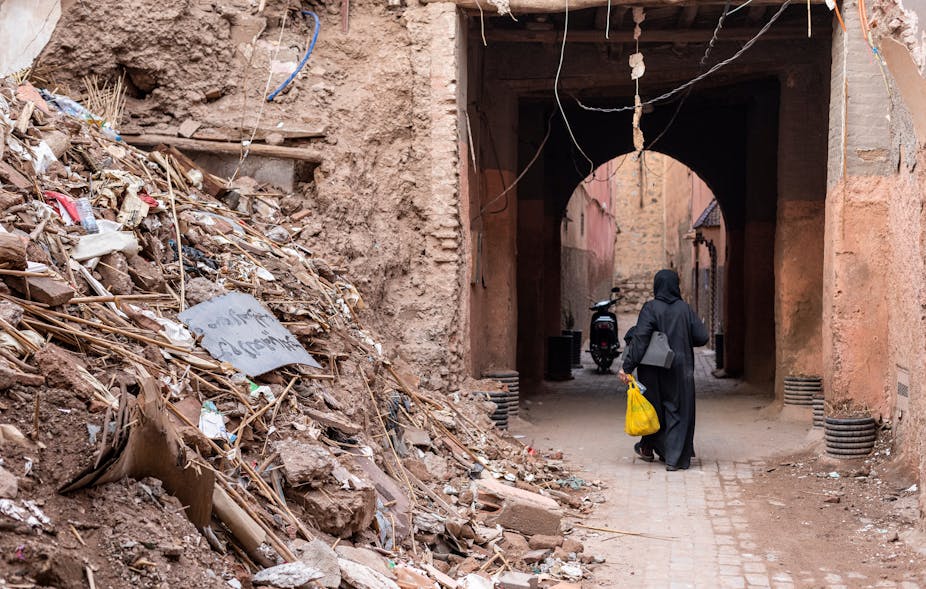The 6.8 magnitude earthquake that struck Morocco’s Atlas mountains on September 8 killed more than 2,000 people and left thousands more homeless. Parts of the old medina in the nearby city of Marrakech, a Unesco world heritage site, were left badly damaged.
In this episode of The Conversation Weekly podcast, two months after the earthquake, we hear why Marrakech and its medina are so important to Islamic heritage – and why some researchers are worried that the expertise of the city’s traditional artisans could be overlooked in the reconstruction.
Nour Eddine Nachaoune was on his moped when the earthquake struck. He didn’t feel anything unusual, but began to see passersby acting strangely. “People were running, then stopping – they seemed disorientated,” he remembers. Nachaoune is an expert in Moroccan heritage at Mohammed V University in Rabat, and lives in Marrakech.
After going to his home in the new part of the city to check his family were alright, he went into Marrakech’s old medina where his office is based, inside his father’s old weaving workshop. Like many of the buildings in the medina, it was badly damaged, with cracks on the walls and the facade. Nachaoune recalls:
The medina which I knew had completely changed. This medina, with its colours and smells, I didn’t recognise it. It was devastated. It had become deadly and threatening. It was a terrible shock which traumatised me for many weeks.
Marrakech’s medina holds major architectural importance for Islamic heritage. It was founded in the 11th century by a dynasty known as the Almoravids and then developed further by their successors, the Almohads. Today, quite a bit of this medieval infrastructure remains in Marrakech’s medina.
“This is because when Morocco was a French protectorate, the French administration who was ruling over Marrakech wanted to preserve that medieval part of the city for their own academic study,” explains Abbey Stockstill, a professor of art history and expert in medieval Islamic art at Southern Methodist University in Texas in the US. She’s spent time living and working in Marrakech as part of her research into the development of the city into a medieval metropolis.
Today, the medina is home to numerous artisan workshops that make the ceramic tiles, carved plaster and intricate woodwork that decorate the city. “Visiting these workshops is incredible, primarily because they’re almost all family run,” Stockstill explains. “Rarely do they have storefronts so advertising is primarily done by word of mouth.”
Like much of the medina, many of these artisan workshops were damaged in the earthquake. The artisans are now waiting impatiently for help from state aid programmes aimed at restoring the daily lives of those affected. But Nachaoune warns that Morocco’s artisans were already in the grip of a structural crisis well before the earthquake hit, because of how heavily they rely on the tourist industry. And now he says they’re not being called upon to help with the reconstruction after the earthquake.
The rarity of artisans specialising in traditional construction techniques has become a major problem in recent years. This specific knowledge is starting to disappear, principally because of the modernisation of the construction process and the lack of training programmes to preserve these essential skills.
Listen to The Conversation Weekly podcast for the full interview with Abbey Stockstill and Nour Eddine Nachaoune. A full transcript is now available.
This episode was written and produced by Gemma Ware and Katie Flood with assistance from Mend Mariwany, who also recorded the English voiceover in this episode. Eloise Stevens does our sound design, and our theme music is by Neeta Sarl. Gemma Ware is the executive producer of the show.
Newsclips in this episode from CNN, and BBC News.
You can find us on X, formerly known as Twitter @TC_Audio, on Instagram at theconversationdotcom or via email. You can also subscribe to The Conversation’s free daily email here.
Listen to The Conversation Weekly via any of the apps listed above, download it directly via our RSS feed or find out how else to listen here.

